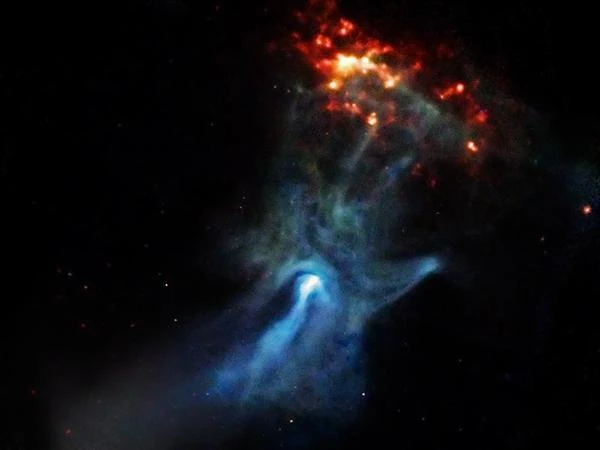
A pulsar is a rapidly rotating neutron star, resulting from the gravitational collapse of a massive star at the end of its life. Its extremely dense core, consisting mainly of degenerate neutrons, generates an intense magnetic field and emits periodic electromagnetic radiation detected as pulses. These signals, often in the radio range, resemble a cosmic lighthouse rotating with remarkable precision.
N.B.:
Under the extreme conditions of pressure and density in a pulsar, neutron matter becomes an extremely dense degenerate fluid. Strong nuclear interactions favor certain energy states, which can induce partial or global alignment of neutron spins, thus producing macroscopic magnetization.
A pulsar is a compact object with a typical mass between 1.4 and 2 solar masses, but reduced to a radius of about 10 to 15 km. Its average density exceeds \(10^{17} \, \mathrm{kg/m^3}\), comparable to nuclear density. Neutron pressure provides the force counterbalancing gravity, thus stabilizing the neutron star.
The magnetic field can reach \(10^8\) to \(10^{11}\) Tesla, billions of times more intense than Earth's. This magnetic field is inclined relative to the rotation axis, causing the pulsed emission perceived on Earth.
The standard model describes the pulsar as a source emitting electromagnetic beams at the magnetic poles. The rapid rotation, with periods ranging from a few milliseconds to a few seconds, induces periodicity in the reception of signals.
The conservation of angular momentum explains the rapid rotation: during the collapse of the initial star, its radius decreases drastically, and the angular velocity increases according to the relation \(\omega = \frac{L}{I}\) where \(L\) is the conserved angular momentum and \(I\) is the moment of inertia of the neutron star.
This rotation is gradually slowed by electromagnetic radiation and the particle wind, causing a slow but measurable increase in the rotation period.
Observations measure the period \(P\), its time derivative \(\dot{P}\), and allow the deduction of the rotational energy loss \(\dot{E}\) related to electromagnetic emission. These parameters provide information on the characteristic age of the pulsar and its surface magnetic field estimated by the classical formula: \( B \approx 3.2 \times 10^{15} \sqrt{P \dot{P}} \quad \mathrm{Tesla} \)
where \(P\) is in seconds and \(\dot{P}\) is dimensionless (variation per second).
| Parameter | Order of Magnitude | Unit | Physical Description |
|---|---|---|---|
| Mass | 1.4 – 2 | Solar Masses (M☉) | Compact gravitational mass of the neutron star |
| Radius | 10 – 15 | km | Typical radius of the neutron star |
| Average Density | ~ \(10^{17}\) | kg/m³ | Density comparable to nuclear matter |
| Magnetic Field | 10^8 – 10^{11} | Tesla | Intensity of the surface magnetic field |
| Rotation Period | 1.4 ms – a few s | seconds | Time between two detected pulses |
| Slowdown Rate \(\dot{P}\) | 10^{-21} – 10^{-12} | s/s | Temporal variation of the period due to braking |
Source: NRAO - The Pulsar Handbook and Kaspi et al., Astrophysical Journal, 2004.
Pulsars are unique natural laboratories for studying extreme physics: dense matter, intense magnetism, general relativity. Their periodic signal, with precision comparable to the best atomic clocks, allows fundamental tests in physics, including the detection of gravitational waves and the measurement of matter under conditions inaccessible in terrestrial laboratories.